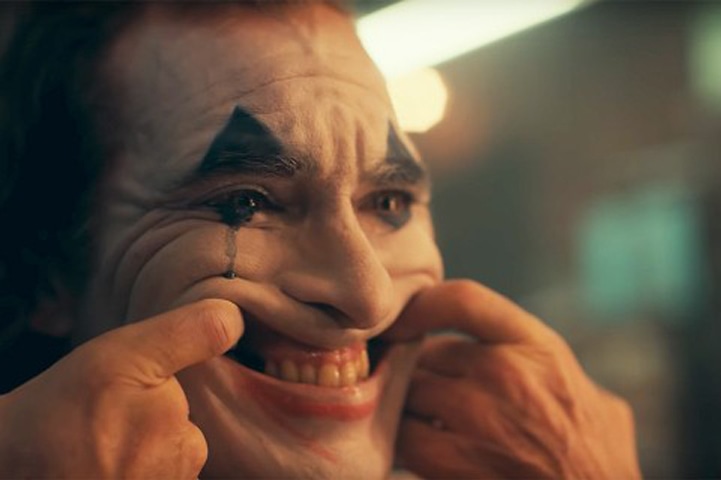
Joaquin Phoenix (Arthur Fleck) holds all the cards in Todd Phillips’ Joker. He is sympathetic, disturbing, and chilling to watch. The film is also shockingly violent. And the violence is so realistic that, coupled with Phoenix’s incredible performance, Joker can be gut-wrenching and difficult to watch. Yet, you can’t tear your eyes away because of the mesmerising Phoenix.
There’s his uncontrolled laugh, that’s the result of a brain injury and which hits him when he’s nervous or scared. It contrasts with the sadness written on his face. There’s the spellbinding, almost snakelike dance. And then there’s the smile, which he forces on himself, and others, by pulling cheeks apart with his thumbs.
While Joker is certainly worth viewing because of Phoenix’s performance alone, it’s also flawed. The dialogue is excellent, but the the social commentary is a mixed bag, and the depiction of mental health problematic.
This is a standalone origin story of Batman’s greatest foe, the Joker. Set in 1981 in the fictional crime-ridden city of Gotham, the film portrays Arthur as a struggling comedian who is suffering from mental illness and takes care of his mum. When Arthur finally tries his hand at a comedy club, he bombs. This gets the attention of his idol, talk show host Murray Franklin (Robert De Niro). Eventually, Arthur gets invited to the show, but all is not as it seems. Soon, Arthur realises that Murray wants to mock him. Here, Arthur is angry and chastises Murray for making fun of a struggling, mentally-ill, comedian for his own amusement.
Todd Phillips’ incredibly atmospheric Joker has a bravura performance from its star Joaquin Phoenix but is marred by its pop psychology
I found this scene interesting because Joker almost does the same thing. As Arthur spirals, the film turns mental health into a spectacle for the audience and a McGuffin for the brutality. Worse, it directly links mental illness with violence by stereotyping and objectifying it. The only mentally-ill character in the film is dangerously violent. Every condition he has is a reason for him to respond to societal ills with violence.
For example, Arthur kills when people make fun of his laughter that’s triggered by a neurological disorder. Arthur kills when he runs out of medication. Arthur kills because he’s not given empathy for this mental illness. In each case, Phillips’ film makes a clear and certain link between violence and mental health issues. This is only because the director wants to use mental illness to add gravitas to his film. Ultimately, Arthur — in no uncertain terms — creates a link between violence and mental health in a monologue.
This is unfortunate because, in the first act or so, Joker tries to realistically depict the plight of people who face mental health challenges in a sympathetic light. Arthur is attacked, he has problems making friends, and he’s treated poorly at work. Here, we connect with Arthur as the film gives us a taste of how society marginalises the vulnerable and how badly they need support. But eventually, the film realises that it’s a comic book movie about a brutal and psychotic supervillain.
As Arthur spirals, the film turns mental health into a spectacle for the audience and a McGuffin for the brutality. Worse, it directly links mental illness with violence by stereotyping and objectifying it. The only mentally-ill character in the film is dangerously violent. Every condition he has is a reason for him to respond to societal ills with violence.
Compare this to Nolan’s version of the character in The Dark Knight (2008). Heath Ledger’s Joker was an anarchist and a sociopath, but the film didn’t make the mistake of studying the mental health of a fictitious supervillain, nor did it make any direct links. Because Joker is such a realistic character study of mental illness in the first act or so, the link it eventually creates rings hollow.
Although these concerns nagged at me throughout, I still enjoyed Joker. The brilliant set design, cinematography, and haunting score give this film an incredible atmosphere. The climactic scenes are deeply suspenseful, while the final link with young Bruce Wayne is incredible fan service.
If Joker continues to dominate the box office, I’m guessing that this version of the character will eventually meet Batman (Robert Pattinson) in Matt Reeve’s upcoming films. Let’s just hope they keep the pop psychology at bay.
Rated R for strong bloody violence, disturbing behaviour, language and brief sexual images
Published in Dawn, ICON, October 13th, 2019













































